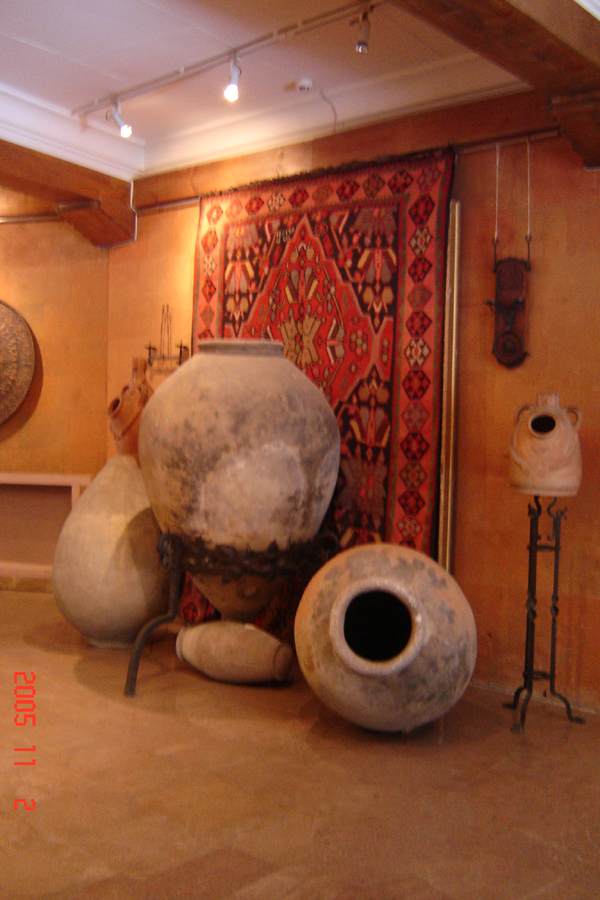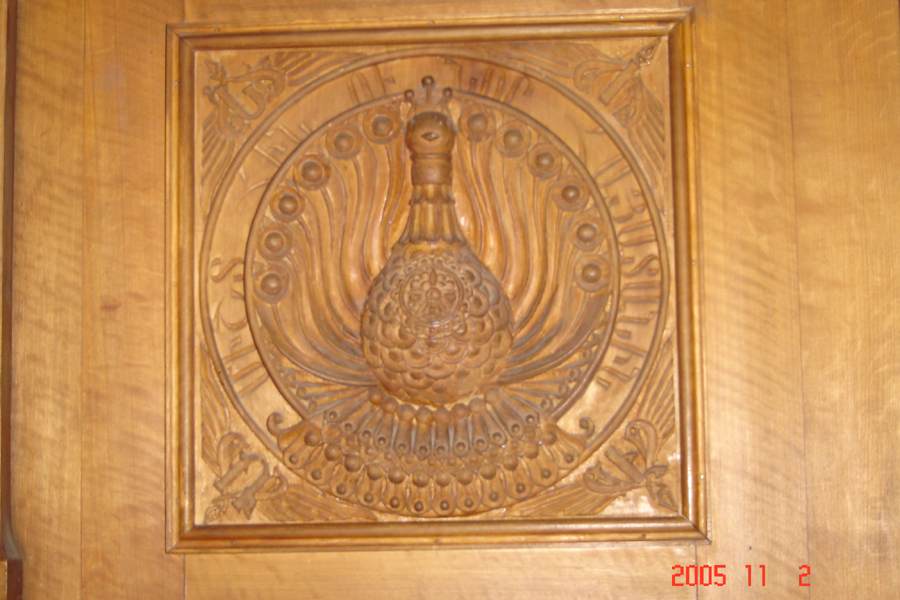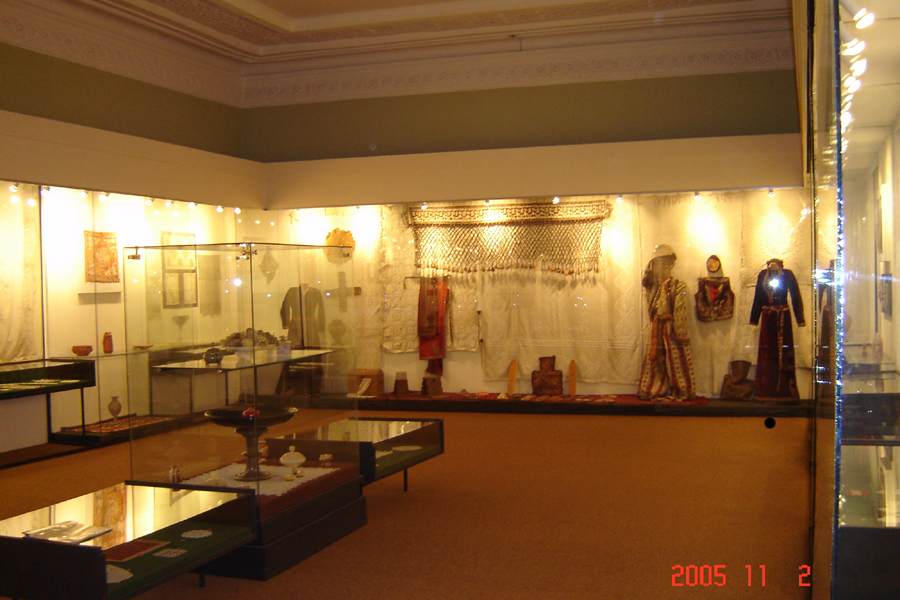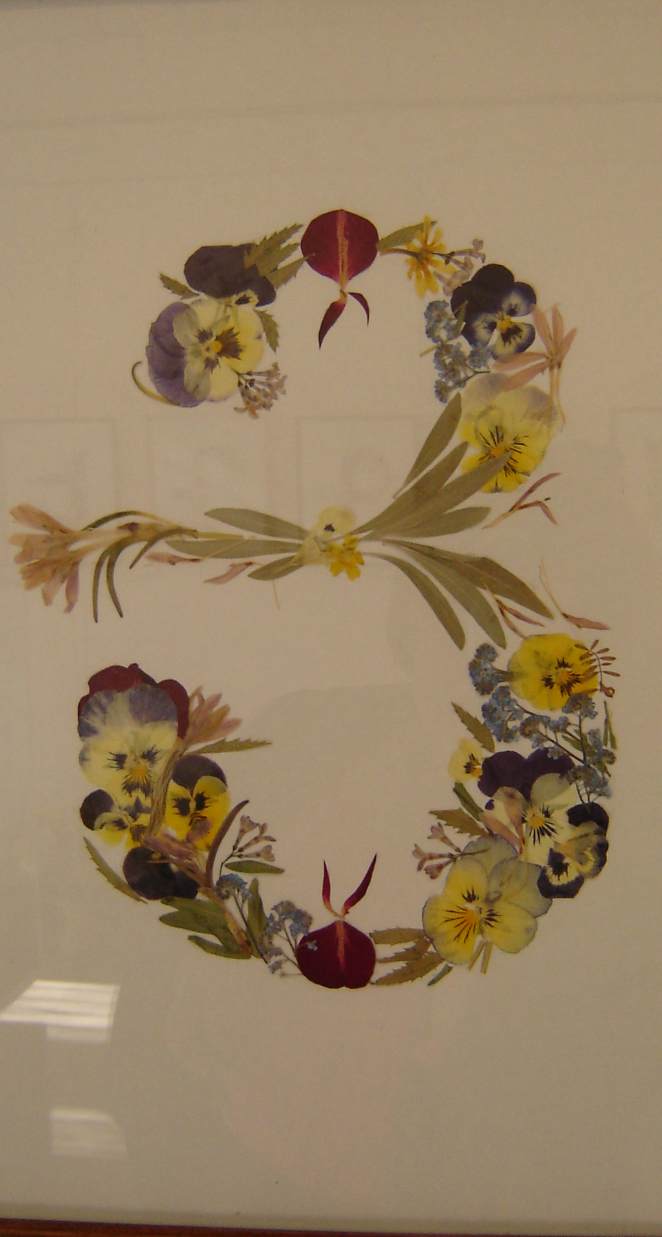
and carpets located on
the First Floor
Armenian News Network / Groong
December 6, 2006
Travel Wire
By Ruth Bedevian
YEREVAN, ARMENIA

|
|
Display of ancient earthenware and carpets located on the First Floor |
To keep the promise that I had made to the museum (and myself), I returned to the National Folk Art Museum of Armenia that I had visited in October a year ago. Located at 64 Abovian Street, it is a short cab ride - or a healthy stroll uphill (if one is predisposed on a sunny autumn day) from Republic Square to the end of Abovian Street.
At that time my friend Gohar and I had been fortunate recipients of a personal tour of the museum by Adelaida Ashotovna Manukyan, the assistant director who holds a degree in Russian Language and Literature. She took Ashot from her father's name and uses it in the Russian style by adding the `ovna.' Her first name comes from an Austrian town founded after a princess.
`I do this work with great pleasure,' Ms. Manukyan declared at the onset. She kindly guided us through each display case with detailed narratives. She has been working with the museum since 1991. Nodding her head with emotion she declared to us, `I vividly remember showing visitors these treasures by flashlight in my early years here.'
Ah yes ! What was the promise that brought me back to the museum? A `gsag.' (purse) In a display case I had spied two hand crocheted purses for holding coins and spontaneously remarked, `I have one of those!' Ms. Manukyan with similar spontaneity seized the opportunity and responded, `I want it.' With a full-hearted desire to contribute something of value to this worthwhile repository of Armenian folk art, I abandoned the thought of preserving this family keepsake in a chest of drawers in my home. I promised to give it to the National Folk Art Museum.

|
|
Detail of hand carving on entrance door to second floor |
The museum claims over 12,000 exhibits. The museum's work is not only to preserve the folk artwork of Armenia, but as importantly to foster and encourage craftsmen in their work and maintain contact with cultural counterparts in foreign countries. Efforts are made to take exhibits to other parts of Armenia as well as to nations beyond the borders. Exhibits have been taken worldwide, to such countries as Poland, Sweden, Holland, Denmark, France, the USA, Czechoslovakia, Hungary, Argentina, Japan, Algeria and Nigeria.
`Our most important need now,' Ms. Manukyan explained, `is to obtain a van to take exhibits to other parts of Armenia and to seek out potential talent as part of the national preservation of applied arts.' As an example of the museum's encouragement of artists, Nune Khachatryan's special exhibit of the Armenian alphabet created from flower petals was on display on the first floor of this two story building. Also located on the first floor were exhibits of carpets, rugs and large ancient earthenware (garas) that were used for storing corn, wine etc. The second floor contains an abundance of items in floor-to-ceiling display windows. Some items are original, but authentic reproductions make up the largest part of the collection. Some of the treasures come from donors from the Diaspora. One lady from Syria had donated fifty items of handmade lace. Researched authentic one-of-a-kind crafts are on display. An array of treasures to be admired are wood carvings, silver filigree, boxes decorated with inlays of wheat that look like stone or wood, decorated belts, metal works in hammered designs, old silver purses, carpets, rugs and ceramic ware. Yashma, a stone native to Armenia which looks like silver, was on display. There is also colored yashma which is used to make jewelry. There were replicas of kettles and plates that Artsroun Bergeryan researched from Erepooni artifacts. There were jewelry reproductions from Van. Copies are sold at the Vernisage, but Bergeryan is credited with resurrecting the designs from artwork found on ancient buildings. We saw ancient butter churners also. On display were works by many artisans. An incomplete list follows with names such as Alagjezian, Azatian, Nargisian, Stepanian, Amirian, Avetisian, Norashkharian, Sahakian, Jerbashian, Khurshudian. We viewed embroidery and handmade lace, and, of course, regional costumes. The museum enjoys a good reputation and is open three days each month free for students and children. Midway through our tour, a group of first- year university students joined us.

|
|
View of Armenian costumes and handicrafts in hall display on second floor |
`In 1938 there was a 10 day exhibit in Moscow which included craftsmen from all over the USSR,' explained Ms. Manukyan. `A special exhibit for Armenia was part of the event and it was Anastas Mikoyan who gave the concept to organize groups to teach people handicrafts. Habetnak Babayan was the organizer in 1938 and lived to be 93 years old. He was the original director of the exhibition and was a member of the Academy of Sciences.' The founding of the museum evolved from this event.' She added, `Even a puppet theater was established as part of the exhibition!' Manukyan continued, `By 1978 there was enough of a collection - so rich - that the Soviet Government renamed the exhibition into the National Folk Art Museum and officially established it. At this juncture Vanik (Hovhannes) Sharambeyan became its founding director. Under his leadership the museum experienced successful growth. The present director is Saro Saroukhanyan.' The museum has two branches - The Wood Carving Museum on Paronian Street in Yerevan and a permanent exhibition in Dilijan.
There are 300 folk artists in Yerevan alone. Ms. Manukyan was quick to emphasize that these folk artists do not sell at the Vernisage. `They are highly esteemed artists whose quality of work is judged by specialists in the various areas of expertise. They come to the museum with their art from television exposure and other places of exhibition because they are inspired.' People from abroad come to the museum for business and Manukyan is a source for these artists.

|
|
Petal Art Alphabet by Nune Khachatryan |
While we were visiting in Ms. Manukyan's office, Lucine Mkhitaryan, an artist and historian, stopped in with samples of needle work that her students had done. Lucine teaches a group of 22 young people (girls and boys ages 7-14) authentic needlework in Sos, a village on the outskirts of Yerevan which is a half-hour's drive away. She was making plans to bring her students to the museum. Sophia Galfayan, a nuclear scientist whose passion is needlework, is Lucine's teacher. Lucine showed us a paper that Sophia had written, crediting the needlework of several villages as being the precursor for the designs for 11th century khachkars. It appears that the needlework designs appeared more and more during a period of Armenian history where dispersion made difficult the documentation of the art. Thus the needlework provided the continuity of the ancient designs.
`The more that I excavate, discover and learn - the more I appreciate my people.' Ms. Manukyan stated with deep sincerity. One feels her admiration. Before coming to the museum to work, Manukyan taught in a village called Hye Tagh (Armenian Place). It is south of Etchmiadzin and is surrounded by villages inhabited by non-Armenians. The people lived in dire conditions with no electricity. She wanted to keep the people of the village from assimilation, to cultivate their Armenian heritage. As a parting tribute, she was honored with an invitation to take part in the Last Bell, a festive tradition throughout Armenia marking the end of high school and entrance into the mainstream of adulthood. `She concluded, `Armenians are very forgiving people and wait for better days.'
I departed yet another museum of Armenia with pride and emotion, admiring this ancient nation that honors its history and whose people diligently pursue academic interest in their origins. Most poignant is the fulfillment existing in my heart of having returned a family heirloom to its homeland - the `gsag' that my ancestors had brought with them to America in 1900 from the village of Soorsoree in Kharpert.
-- Ruth Bedevian continues her visits in Armenia. Many of her articles are at: http://www.groong.org/orig/armeniahousemuseums.html
|
Redistribution of Groong articles, such as this one, to any other
media, including but not limited to other mailing lists and Usenet
bulletin boards, is strictly prohibited without prior written
consent from Groong's Administrator. � Copyright 2006 Armenian News Network/Groong. All Rights Reserved. |
|---|